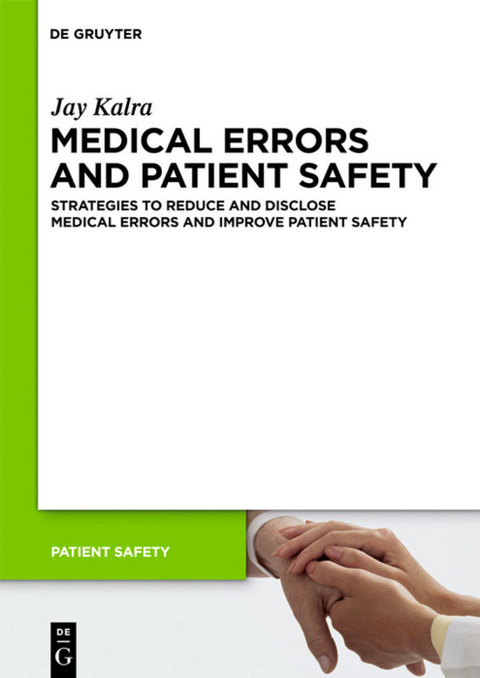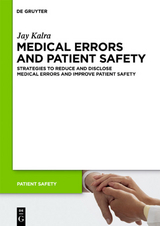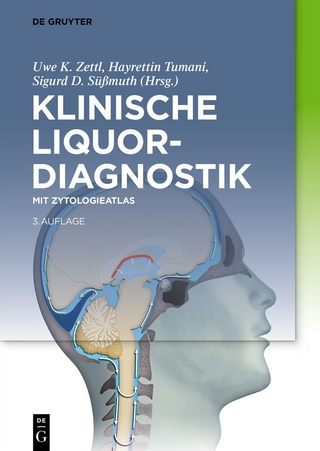Medical Errors and Patient Safety
Strategies to reduce and disclose medical errors and improve patient safety
Seiten
New Series: Patient Safety Medical errors do not only occur in the laboratory, but pose a direct threat to patient safety. The clinical laboratory is an integral part of care, and the results of analytics are an essential component of informed decision-making for clinicians. Efforts to avoid laboratory errors, especially minimizing pre- and postanalytical errors, are in the responsibility of laboratory professionals.The new handbook series with the international known editors Oswald Sonntag and Mario Plebani fills a vacancy in the relevant and promising area of patient safety and quality assurance.
Is the reporting of medical errors changing? This book shows with real cases from health care and beyond that most errors come from flaws in the system. It also shows why they don't get reported and how medical error disclosure around the world is shifting away from blaming people, to a "no-fault" model that seeks to improve the whole system of care. The book intends to provide an introduction to medical errors that result in preventable adverse events. It will examine issues that stymie efforts made to reduce preventable adverse events and medical errors, and will moreover highlight their impact on clinical laboratories and other areas, including educational, bioethical, and regulatory issues. Varying error rates of 0.1-9.3% in clinical diagnostic laboratories have been reported in the literature. While it is suggested that fewer errors occur in the laboratory than in other hospital settings, the quantum of laboratory tests used in healthcare entails that even a small error rate may reflect a large number of errors. The interdependence of surgical specialties, emergency rooms, and intensive care units - all of which are prone to higher rates of medical errors - with clinical diagnostic laboratories entails that reducing error rates in laboratories is essential to ensuring patient safety in other critical areas of healthcare. The author maintains that many such errors are preventable provided that appropriate attention is paid to systemic factors involved in laboratory errors. This book identifies possible intelligent system approaches that can be adopted to help control and eliminate these errors. It is a valuable tool for physicians, clinical biochemists, research scientists, laboratory technologists and anyone interested in reducing adverse events at all levels of healthcare processes.
Is the reporting of medical errors changing? This book shows with real cases from health care and beyond that most errors come from flaws in the system. It also shows why they don't get reported and how medical error disclosure around the world is shifting away from blaming people, to a "no-fault" model that seeks to improve the whole system of care. The book intends to provide an introduction to medical errors that result in preventable adverse events. It will examine issues that stymie efforts made to reduce preventable adverse events and medical errors, and will moreover highlight their impact on clinical laboratories and other areas, including educational, bioethical, and regulatory issues. Varying error rates of 0.1-9.3% in clinical diagnostic laboratories have been reported in the literature. While it is suggested that fewer errors occur in the laboratory than in other hospital settings, the quantum of laboratory tests used in healthcare entails that even a small error rate may reflect a large number of errors. The interdependence of surgical specialties, emergency rooms, and intensive care units - all of which are prone to higher rates of medical errors - with clinical diagnostic laboratories entails that reducing error rates in laboratories is essential to ensuring patient safety in other critical areas of healthcare. The author maintains that many such errors are preventable provided that appropriate attention is paid to systemic factors involved in laboratory errors. This book identifies possible intelligent system approaches that can be adopted to help control and eliminate these errors. It is a valuable tool for physicians, clinical biochemists, research scientists, laboratory technologists and anyone interested in reducing adverse events at all levels of healthcare processes.
Jay Kalra, College of Medicine, University of Saskatchewan, Canada.
lt;p>"Ein komprimierter Überblick über modernes Fehlermanagement."
In: Chirurgenmagazin 4/2011
| Erscheint lt. Verlag | 17.5.2011 |
|---|---|
| Reihe/Serie | Patient Safety ; 1 |
| Zusatzinfo | 10 b/w ill., 10 b/w tbl. |
| Verlagsort | Berlin/Boston |
| Sprache | englisch |
| Maße | 170 x 240 mm |
| Gewicht | 237 g |
| Themenwelt | Medizin / Pharmazie ► Medizinische Fachgebiete ► Laboratoriumsmedizin |
| Medizin / Pharmazie ► Medizinische Fachgebiete ► Notfallmedizin | |
| Schlagworte | Behandlungsfehler • Emergency Medicine • Intensive care • Intensivmedizin • laboratory medicine • Labormedizin • medical malpractice • Medical Malpractice; Intensive Care; Laboratory Medicine; Emergency Medicine • Medizinschaden • Notfallmedizin • Patienten • Patientensicherheit |
| ISBN-10 | 3-11-024949-9 / 3110249499 |
| ISBN-13 | 978-3-11-024949-1 / 9783110249491 |
| Zustand | Neuware |
| Haben Sie eine Frage zum Produkt? |
Mehr entdecken
aus dem Bereich
aus dem Bereich
Buch | Softcover (2021)
Deutscher Ärzteverlag
CHF 41,95
mit Zytologieatlas
Buch | Hardcover (2025)
De Gruyter (Verlag)
CHF 244,90
ein praxisorientiertes Handbuch
Buch | Hardcover (2023)
Wiley-VCH Verlag GmbH
CHF 69,85




